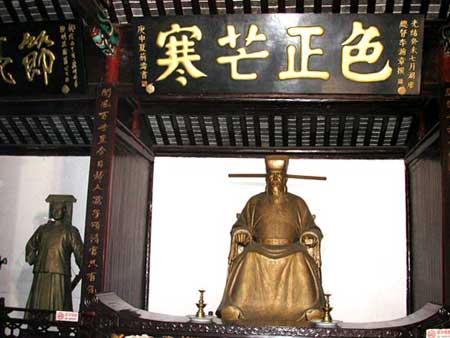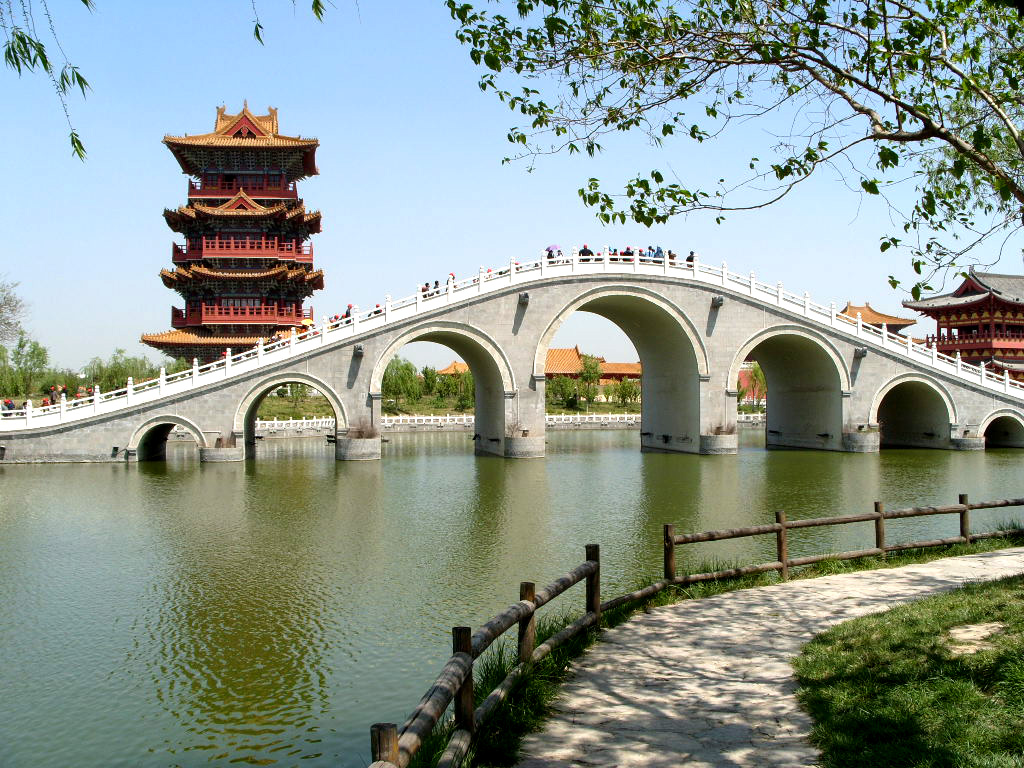Overview
 Kaifeng is one of the Seven Ancient Capitals of China.In 364 BC, the state of Wei during the Warring States Period founded a city called Daliang as its capital in this area. During this period, the first of many canals in the area was constructed; it linked a local river to the Huang He. When the State of Wei was conquered by the Qin, Kaifeng was destroyed and abandoned except for a mid-sized market town, which remained in its place.During the Song Dynasty, Kaifeng was the capital with a population of over 400,000, living both inside and outside the city wall.
Kaifeng is one of the Seven Ancient Capitals of China.In 364 BC, the state of Wei during the Warring States Period founded a city called Daliang as its capital in this area. During this period, the first of many canals in the area was constructed; it linked a local river to the Huang He. When the State of Wei was conquered by the Qin, Kaifeng was destroyed and abandoned except for a mid-sized market town, which remained in its place.During the Song Dynasty, Kaifeng was the capital with a population of over 400,000, living both inside and outside the city wall.
In 1049, Youguosi Pagoda, or Iron Pagoda as it is called today, was constructed, which measures 54.7 m in height. It has survived the destruction of wars and floodings and become the oldest landmark in this ancient city. Another Song D ynasty pagoda, Bo Ta , from 974, has been partially destroyed.
ynasty pagoda, Bo Ta , from 974, has been partially destroyed.
Another well-known sight was the astronomical clock tower of the engineer, scientist, and statesman Su Song (1020-1101 AD). It was crowned with a rotating armillary sphere that was hydraulic-powered (i.e. by waterwheel and clepsydra clock), yet it incorporated an escapement mechanism two hundred years before they were found in clockworks of Europe, and featured the first known endless power-transmitting chain drive.
Kaifeng is also known for having the oldest extant Jewish community in China, the Kaifeng Jews.
Attractions
Iron Pagoda
Iron Pagoda is located in Iron Pagoda Park, which is in the northeastern part of Kaifeng City. The pagoda still presents an imposing figure even after hundreds of years. The Iron Pagoda is appropriately named. Covered with glazed tiles in the color of iron, it looks like an iron pillar from a distance.
Dragon Pavilion 
Situated in Dragon Pavilion Park in the northwest part of Kaifeng City, Dragon Pavilion is actually a palace and not a traditional pavilion. The ‘must see' sights in Dragon Pavilion Park include examples of Qing Dynasty (1644-1911) and Northern Song Dynasty (960-1127) architectures, the Pan and Yang lakes and the renowned landscaped gardens.
Qingming Riverside Landscape Garden
 The painting Chinese Symphonic Picture Riverside Scene at Qingming Festival, by Zhang Zeduan of the Northern Song Dynasty (960-1127), captures the prosperity of ancient Kaifeng City. Millennium City Park is a large-scaled scenic amusement park which offers tourists an opportunity to step back in history and explore both the flourishing sights of the ancient city and to experience the daily routines of the ancient inhabitants.
The painting Chinese Symphonic Picture Riverside Scene at Qingming Festival, by Zhang Zeduan of the Northern Song Dynasty (960-1127), captures the prosperity of ancient Kaifeng City. Millennium City Park is a large-scaled scenic amusement park which offers tourists an opportunity to step back in history and explore both the flourishing sights of the ancient city and to experience the daily routines of the ancient inhabitants.
Imperial Street of Song Dynasty
With the length of more than 400 meters (about 437.4 yards), Imperial Street of Song Dynasty is a recreation of the original Imperial Street which flourished with merchants during the Song Dynasty. Rows of antique stores line the street and browsing through their treasures conjures memories of old Kaifeng.
Lord Bao Temple
Located on the west bank of Baogong Lake, the Memorial Temple of Lord Bao is an excellent example of a complex built in the architectural style of the Song Dynasty. Lord Bao was an exemplary official and his name became a household word in China. Tourists will learn about the incorruptibility of Lord Bao through the historical materials, inscriptions and waxwork exhibits on display in the temple.
Kaifeng Yamun
Kaifeng Yamun (administration office) is a theme-based scenic spot which recreates the stateliness and honest politics of Lord Bao and the Kaifeng Yamun. This is an excellent place to experience the Chinese culture of Yamun.
|
Xiangguo Te mple mple
Built in AD 555 in the city center, Xiangguo Temple flourished with the support of the imperial family of the Northern Song Dynasty (960-1127). With the large-scaled area and various Buddhist activities, the temple is one of the ten famous ancient Buddhist temples in China.

Kaifeng Museum
Completed and opened to public in 1988, Kaifeng Museum (which was the former Henan Provincial Museum) exhibits the revolutionary achievements of Kaifeng in Modern China. Also on display are exhibits highlighting the most representative period of Kaifeng history - Song Dynasty, which is considered the glory days of Kaifeng.
Dining

The cooking culture of Kaifeng may well be rich and colorful, there is sediment of the cooking culture of Jin and Yuan dynasty through the ages, there are wild games of local characteristic delicacy from mountain too, there are results from modern plural cultural exchanges, these form Kaifeng unique food and beverage culture, i.e. Kaifeng flavor, its characteristic can summarize as ' dialyse, produce beautiful in being sincere, hit the quintessence of containing roughly '. Futai floor, Beilaishun, Western food restaurant of Huamei, Jiang NanChun, Sigma restaurant, Fucheng beef in hot pots hot pot city, one dumpling hall, eastern dumpling king, Wu ji sauced bone stew restaurant ,etc. the famous special restaurant of Kaifeng always.
Shopping
Travel to Kaifeng, except that Kaifeng Bian embroidered, officer's porcelain, wood engraving picture of Zhuxian town can make people feast one's eyes, in temple market of the big prime minister, market and supermarket of the shopping center of Kaifeng can buy it. The whole city of Kaifeng has more than 100,000 sites of commercial service, all kinds of more than 300 country fairs. There are the street and drum-tower street after bookstore street, temple of city center in the main business street, the main market has exemplary market, big prime minister's temple market, people's Department Store ,etc.
|